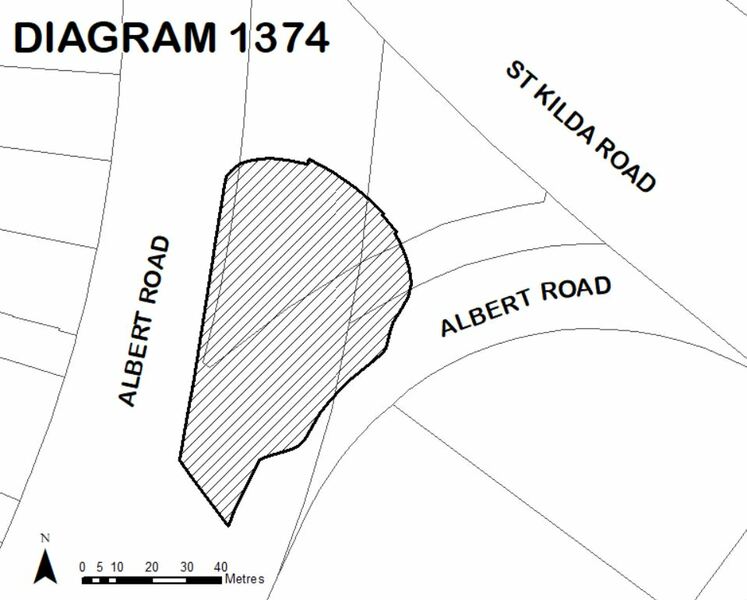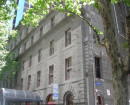Back to search results
SOUTH AFRICAN SOLDIERS MEMORIAL
29A ALBERT ROAD MELBOURNE, PORT PHILLIP CITY
SOUTH AFRICAN SOLDIERS MEMORIAL
29A ALBERT ROAD MELBOURNE, PORT PHILLIP CITY
All information on this page is maintained by Heritage Victoria.
Click below for their website and contact details.
Victorian Heritage Register
-
Add to tour
You must log in to do that.
-
Share
-
Shortlist place
You must log in to do that.
- Download report

SOUTH AFRICAN SOLDIERS MEMORIAL SOHE 2008














On this page:
Statement of Significance
What is significant?
The South African War Memorial Committee was formed at a public meeting in 1911 to raise funds for a memorial to honour the soldiers who fought and died in the Boer War. The architect Irwin & Stevenson won the design competition and the memorial was completed in mid 1924. The memorial was to have originally been hexagonal in plan with six bronze lions but lack of funds resulted in a more simple design. Eventually more money was raised and the four sandstone lions, designed and sculpted by Stanley Hammond, were added to the memorial in 1952. The memorial is a grey granite obelisk set on a podium. It is embellished with a bronze dagger, plaque and a wreath which is decorated with eucalyptus motifs. The four sandstone lions are set on granite pedestals on each corner of the podium.
How is it significant?
The memorial is of historical, social and aesthetic importance to the state of Victoria.
Why is it significant?
The South African Soldiers' War Memorial is of considerable historical and social significance as the major memorial associated with the Boer War in Victoria. Its monumental size and landmark position imbue the memorial with a strong, symbolic presence. It is the only memorial built in Victoria to commemorate all Australians who took part in the war, rather than local soldiers. The Boer War was a pivotal moment in Australia's history. It was the first time that volunteers from Australia and New Zealand had fought together in an overseas war and the first time these troops paraded together in Melbourne and Sydney, presaging the ANZAC tradition. The war was at a time of growing national consciousness for an Australia declaring its own nationhood.
The memorial is a poignant symbol of the war and conveys the profound sentiments of the Victorian community towards this important event in Australian history. The incorporation of eucalypt motifs into the bronze wreath reflects the rising nationalism of the time.
Show more
Show less
-
-
SOUTH AFRICAN SOLDIERS MEMORIAL - Permit Exemptions
General Exemptions:General exemptions apply to all places and objects included in the Victorian Heritage Register (VHR). General exemptions have been designed to allow everyday activities, maintenance and changes to your property, which don’t harm its cultural heritage significance, to proceed without the need to obtain approvals under the Heritage Act 2017.Places of worship: In some circumstances, you can alter a place of worship to accommodate religious practices without a permit, but you must notify the Executive Director of Heritage Victoria before you start the works or activities at least 20 business days before the works or activities are to commence.Subdivision/consolidation: Permit exemptions exist for some subdivisions and consolidations. If the subdivision or consolidation is in accordance with a planning permit granted under Part 4 of the Planning and Environment Act 1987 and the application for the planning permit was referred to the Executive Director of Heritage Victoria as a determining referral authority, a permit is not required.Specific exemptions may also apply to your registered place or object. If applicable, these are listed below. Specific exemptions are tailored to the conservation and management needs of an individual registered place or object and set out works and activities that are exempt from the requirements of a permit. Specific exemptions prevail if they conflict with general exemptions. Find out more about heritage permit exemptions here.Specific Exemptions:
NilIntroduction
A heritage permit is required for all works and activities undertaken in relation to VHR places and objects. Certain works and activities are exempt from a heritage permit, if the proposed works will not harm the cultural heritage significance of the heritage place or object.
Permit Policy
It is recommended that a Conservation Management Plan is utilised to manage the place in a manner which respects its cultural heritage significance.
Permit Exemptions
General Exemptions
General exemptions apply to all places and objects included in the Victorian Heritage Register (VHR). General exemptions have been designed to allow everyday activities, maintenance and changes to your property, which don’t harm its cultural heritage significance, to proceed without the need to obtain approvals under the Act.
Specific exemptions may also apply to your registered place or object. If applicable, these are listed below. Specific exemptions are tailored to the conservation and management needs of an individual registered place or object and set out works and activities that are exempt from the requirements of a permit. Specific exemptions prevail if they conflict with general exemptions.
Specific Exemptions
The works and activities below are not considered to cause harm to the cultural heritage significance of the South African Soldier’s Memorial subject to the following guidelines and conditions:
Guidelines
1. Where there is an inconsistency between permit exemptions specific to the registered place or object (‘specific exemptions’) established in accordance with either section 49(3) or section 92(3) of the Act and general exemptions established in accordance with section 92(1) of the Act specific exemptions will prevail to the extent of any inconsistency.
2. In specific exemptions, words have the same meaning as in the Act, unless otherwise indicated. Where there is an inconsistency between specific exemptions and the Act, the Act will prevail to the extent of any inconsistency.
3. Nothing in specific exemptions obviates the responsibility of a proponent to obtain the consent of the owner of the registered place or object, or if the registered place or object is situated on Crown Land the land manager as defined in the Crown Land (Reserves) Act 1978, prior to undertaking works or activities in accordance with specific exemptions.
4. If a Cultural Heritage Management Plan in accordance with the Aboriginal Heritage Act 2006 is required for works covered by specific exemptions, specific exemptions will apply only if the Cultural Heritage Management Plan has been approved prior to works or activities commencing. Where there is an inconsistency between specific exemptions and a Cultural Heritage Management Plan for the relevant works and activities, Heritage Victoria must be contacted for advice on the appropriate approval pathway.
5. Specific exemptions do not constitute approvals, authorisations or exemptions under any other legislation, Local Government, State Government or Commonwealth Government requirements, including but not limited to the Planning and Environment Act 1987, the Aboriginal Heritage Act 2006, and the Environment Protection and Biodiversity Conservation Act 1999 (Cth). Nothing in this declaration exempts owners or their agents from the responsibility to obtain relevant planning, building or environmental approvals from the responsible authority where applicable.
6. Care should be taken when working with heritage buildings and objects, as historic fabric may contain dangerous and poisonous materials (for example lead paint and asbestos). Appropriate personal protective equipment should be worn at all times. If you are unsure, seek advice from a qualified heritage architect, heritage consultant or local council heritage advisor.
7. The presence of unsafe materials (for example asbestos, lead paint etc) at a registered place or object does not automatically exempt remedial works or activities in accordance with this category. Approvals under Part 5 of the Act must be obtained to undertake works or activities that are not expressly exempted by the below specific exemptions.
8. All works should be informed by a Conservation Management Plan prepared for the place or object. The Executive Director is not bound by any Conservation Management Plan, and permits still must be obtained for works suggested in any Conservation Management Plan.
Conditions
1. All works or activities permitted under specific exemptions must be planned and carried out in a manner which prevents harm to the registered place or object. Harm includes moving, removing or damaging any part of the registered place or object that contributes to its cultural heritage significance.
2. If during the carrying out of works or activities in accordance with specific exemptions original or previously hidden or inaccessible details of the registered place are revealed relating to its cultural heritage significance, including but not limited to historical archaeological remains, such as features, deposits or artefacts, then works must cease and Heritage Victoria notified as soon as possible.
3. If during the carrying out of works or activities in accordance with specific exemptions any Aboriginal cultural heritage is discovered or exposed at any time, all works must cease and the Secretary (as defined in the Aboriginal Heritage Act 2006) must be contacted immediately to ascertain requirements under the Aboriginal Heritage Act 2006.
4. If during the carrying out of works or activities in accordance with specific exemptions any munitions or other potentially explosive artefacts are discovered, Victoria Police is to be immediately alerted and the site is to be immediately cleared of all personnel.
5. If during the carrying out of works or activities in accordance with specific exemptions any suspected human remains are found the works or activities must cease. The remains must be left in place and protected from harm or damage. Victoria Police and the State Coroner’s Office must be notified immediately. If there are reasonable grounds to believe that the remains are Aboriginal, the State Emergency Control Centre must be immediately notified on 1300 888 544, and, as required under s.17(3)(b) of the Aboriginal Heritage Act 2006, all details about the location and nature of the human remains must be provided to the Secretary (as defined in the Aboriginal Heritage Act 2006.
Exempt works and activities
The following permit exemptions are not considered to cause harm to the cultural heritage significance of South African Soldier’s Memorial.
Current works (2023-2025)· Works associated with the construction of Metro Tunnel in accordance with the amended Domain Precinct Development Plan (October 2022), as approved by the Minister for Planning. This permit exemption is not intended to override the intention or conditions of the heritage permits issued by Heritage Victoria for the Metro Tunnel works in the Domain Precinct.Transport infrastructure· Works associated with operating and maintaining the existing road and public transport infrastructure including all railways, tramways, roadways, footpaths, kerbs and channels, traffic lights, car parks, signs, fire hydrants, parking meters, street lighting, stations, elevators, seating and shelters.· New works within the underground component of the Metro Tunnel infrastructure.
-
-
-
-
-
SHRINE OF REMEMBRANCE
 Victorian Heritage Register H0848
Victorian Heritage Register H0848 -
FORMER KELLOW FALKINER SHOWROOMS
 Victorian Heritage Register H0668
Victorian Heritage Register H0668 -
ST LUKES CHURCH
 Victorian Heritage Register H0218
Victorian Heritage Register H0218
-
10 Down Street
 Yarra City
Yarra City
-
-












